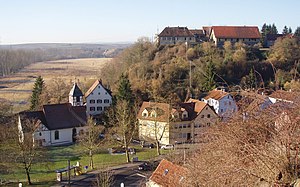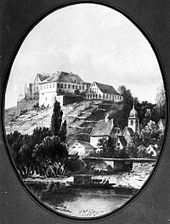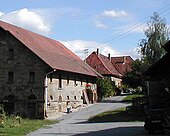Neippergsches Schloss Klingenberg
| Neippergsches Schloss Klingenberg | ||
|---|---|---|
|
Klingenberg Castle from the northeast |
||
| Alternative name (s): | Klingenberg Castle | |
| Creation time : | 13th century | |
| Castle type : | Spurburg | |
| Conservation status: | Remaining stocks. Residential and farm buildings | |
| Standing position : | Aristocratic seat, robber baron's castle, castle | |
| Place: | Klingenberg | |
| Geographical location | 49 ° 7 '7 " N , 9 ° 9' 28" E | |
|
|
||
The Neippergsche Schloss , also called Burg Klingenberg , in the Heilbronn district of Klingenberg on a mountain spur above the Neckar goes back to the castle of the medieval local nobility, was acquired by the Lords of Neipperg in the early 15th century and was then based on the Neipperg Castle From the middle of the 16th century until the construction of the castle in Schwaigern, its headquarters. Remains from many building periods have been preserved in the property, which has been rebuilt many times and is now used for residential and commercial purposes.
history
In the 13th century, Klingenberg Castle, along with the village of Klingenberg and the church set, was owned by the Weißenburg Monastery , which lent its Klingenberg property to the Margraviate of Baden , who enfeoffed the Lords of Klingenberg with a Reinbot (Remboto, Renbot) were first mentioned by Klingenberg . The Reinbotstraße in Klingenberg was named after him. In 1360, the Lords of Klingenberg took part in the war against Charles IV on the side of Counts Eberhard der Greiner and Ulrich IV . The castle was taken by the army of Count Palatine Ruprecht , also because the castle had become a robber baron's castle "because of robbery". On October 31, 1360, Emperor Karl IV allowed Heilbronn to use the stones of the Hohenstaufen castle, which is said to have been used to build the tower later called Götzenturm in Heilbronn . In 1361 the emperor also banned the rebuilding of the castle. In 1389 a "Burgstadel" (castle stable) is called.
In 1407 and 1417 Eberhard von Neipperg acquired the margravial fief in two halves. A “farmstead” is mentioned in the feudal contract. The lords of Neipperg erected new buildings on the foundations of the castle. In 1439 and 1478 a castle is mentioned, in 1522 a castle, and in 1539 an associated wine press. Construction activity is also reported in 1577 under Philipp von Neipperg, who had his seat and thus the main seat of the family in Klingenberg since 1554. From 1590 a forecourt is attested. In 1673 a distinction is made between an "upper house" and a desolate stone house. The main building still preserved, the single-storey "Schlössle" facing the courtyard, was built in the middle of the 17th century instead of a previous building from the 16th century. At the same time there were plans to build a new wine press, a dairy and a cattle shed. The complex remained the headquarters of the Lords of Neipperg until Schwaigern Castle was built in 1702 .
In the years 1858 and 1861 the farm buildings were destroyed by fires and then rebuilt by the Heilbronn city architect Louis de Millas . The facility was damaged in World War II. The servant's house, the corner blocks of which date from 1526 and which was rebuilt in the Baroque style in the 18th century, still has an emergency roof from the repairs after the Second World War. In 1950 a chapel between the servants' house and the curtain wall with artistic glazing by Josef de Ponte was set up.
Second World War
During the Second World War , Slovenian slave laborers were employed at the castle . According to reports from the Bregar family from Čimerno near Radeče in present-day Slovenia, who were housed there from the spring of 1942 until the end of the war, up to 28 forced laborers were housed there at the same time. These were used in the fields. They had to sow wheat, process cucumbers, tomatoes, potatoes, sugar beets and other crops when the food was very poor. The fields were worked with tractors and other machines. Most of the vegetables were grown for the Wehrmacht.
description
The castle stands in the southwest on the remains of a castle wall with fragments of a Staufer keep or residential tower . In the east corner of the castle there is a basement of the old castle with a cellar with walls up to a meter thick and a vault. "Schlössle" and servants' house were rebuilt or rebuilt in the 18th century on foundations from the 16th century. Cattle shed and fruit storage were built in 1860. The part of the barn adjoining the fruit store was built in 1875 over an older cellar.
The castle is used today for residential and commercial purposes.
literature
- Julius Fekete , Simon Haag, Adelheid Hanke, Daniela Naumann: Heilbronn district . (= Monument topography Federal Republic of Germany , cultural monuments in Baden-Württemberg, Volume I.5.). Theiss, Stuttgart 2007, ISBN 978-3-8062-1988-3 , pp. 224-225 .
Individual evidence
- ↑ Irena Fürst "Slovenski izgnanci 1941-1945 (14), Družini Bregar in Knez" (German: The Slovenian Expellees 1941-1945 (14th part) - The Bregar and Knez families), Slovenian weekly newspaper Dolenjski list , Novo mesto , 2. April 2015, p. 20







